The Intel 6th Gen Skylake Review: Core i7-6700K and i5-6600K Tested
by Ian Cutress on August 5, 2015 8:00 AM ESTGenerational Tests on the i7-6700K: Gaming Benchmarks on Mid-Range GPUs
Alien: Isolation
If first person survival mixed with horror is your sort of thing, then Alien: Isolation, based off of the Alien franchise, should be an interesting title. Developed by The Creative Assembly and released in October 2014, Alien: Isolation has won numerous awards from Game Of The Year to several top 10s/25s and Best Horror titles, ratcheting up over a million sales by February 2015. Alien: Isolation uses a custom built engine which includes dynamic sound effects and should be fully multi-core enabled.
For low end graphics, we test at 720p with Ultra settings, whereas for mid and high range graphics we bump this up to 1080p, taking the average frame rate as our marker with a scripted version of the built-in benchmark.
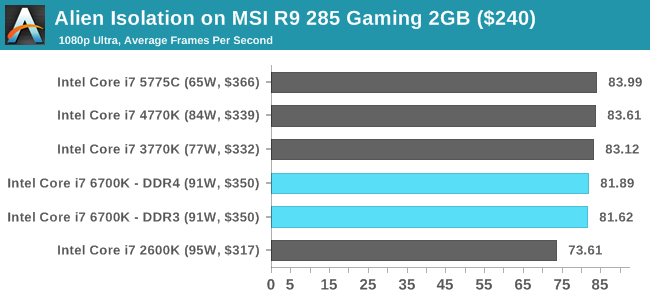
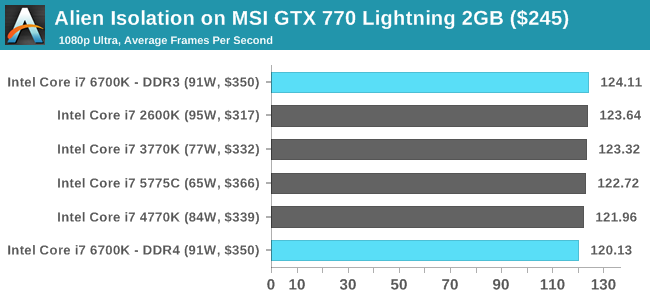
Total War: Attila
The Total War franchise moves on to Attila, another The Creative Assembly development, and is a stand-alone strategy title set in 395AD where the main story line lets the gamer take control of the leader of the Huns in order to conquer parts of the world. Graphically the game can render hundreds/thousands of units on screen at once, all with their individual actions and can put some of the big cards to task.
For low end graphics, we test at 720p with performance settings, recording the average frame rate. With mid and high range graphics, we test at 1080p with the quality setting. In both circumstances, unlimited video memory is enabled and the in-game scripted benchmark is used.
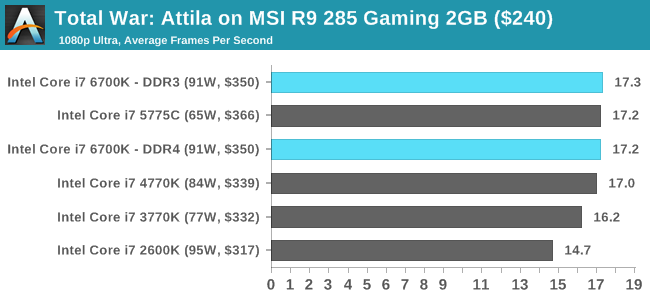
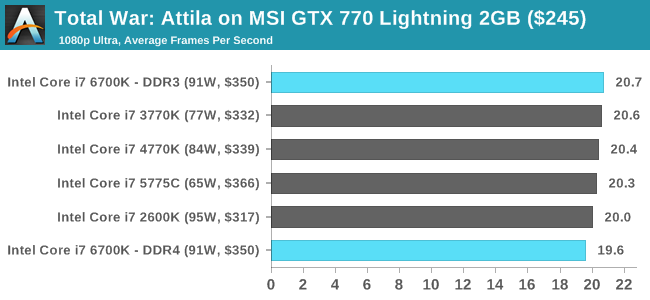
Grand Theft Auto V
The highly anticipated iteration of the Grand Theft Auto franchise finally hit the shelves on April 14th 2015, with both AMD and NVIDIA in tow to help optimize the title. GTA doesn’t provide graphical presets, but opens up the options to users and extends the boundaries by pushing even the hardest systems to the limit using Rockstar’s Advanced Game Engine. Whether the user is flying high in the mountains with long draw distances or dealing with assorted trash in the city, when cranked up to maximum it creates stunning visuals but hard work for both the CPU and the GPU.
For our test we have scripted a version of the in-game benchmark, relying only on the final part which combines a flight scene along with an in-city drive-by followed by a tanker explosion. For low end systems we test at 720p on the lowest settings, whereas mid and high end graphics play at 1080p with very high settings across the board. We record both the average frame rate and the percentage of frames under 60 FPS (16.6ms).
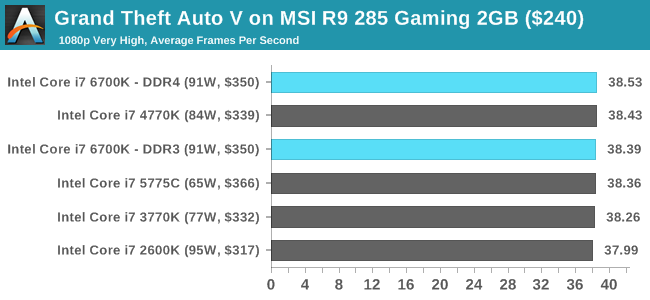
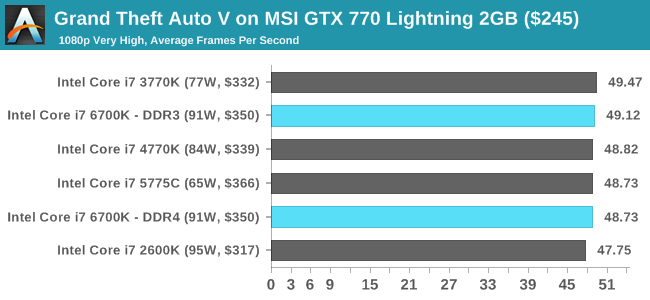
GRID: Autosport
No graphics tests are complete without some input from Codemasters and the EGO engine, which means for this round of testing we point towards GRID: Autosport, the next iteration in the GRID and racing genre. As with our previous racing testing, each update to the engine aims to add in effects, reflections, detail and realism, with Codemasters making ‘authenticity’ a main focal point for this version.
GRID’s benchmark mode is very flexible, and as a result we created a test race using a shortened version of the Red Bull Ring with twelve cars doing two laps. The car is focus starts last and is quite fast, but usually finishes second or third. For low end graphics we test at 1080p medium settings, whereas mid and high end graphics get the full 1080p maximum. Both the average and minimum frame rates are recorded.
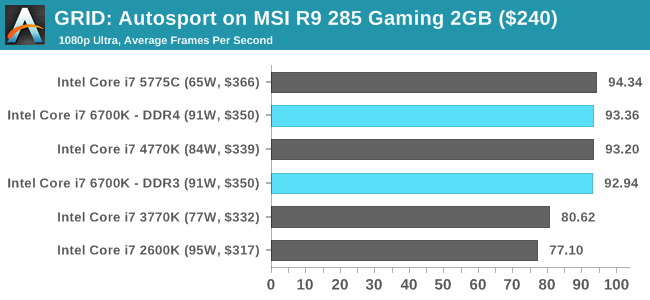
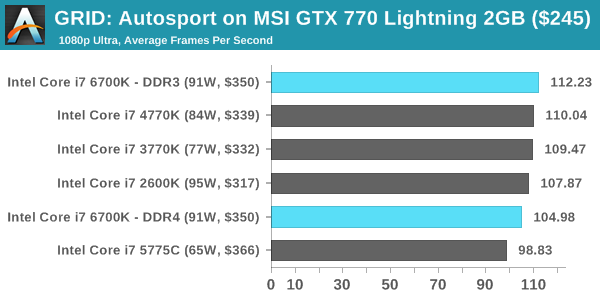
Middle-Earth: Shadow of Mordor
The final title in our testing is another battle of system performance with the open world action-adventure title, Shadow of Mordor. Produced by Monolith using the LithTech Jupiter EX engine and numerous detail add-ons, SoM goes for detail and complexity to a large extent, despite having to be cut down from the original plans. The main story itself was written by the same writer as Red Dead Redemption, and it received Zero Punctuation’s Game of The Year in 2014.
For testing purposes, SoM gives a dynamic screen resolution setting, allowing us to render at high resolutions that are then scaled down to the monitor. As a result, we get several tests using the in-game benchmark. For low end graphics we examine at 720p with low settings, whereas mid and high end graphics get 1080p Ultra. The top graphics test is also redone at 3840x2160, also with Ultra settings, and we also test two cards at 4K where possible.
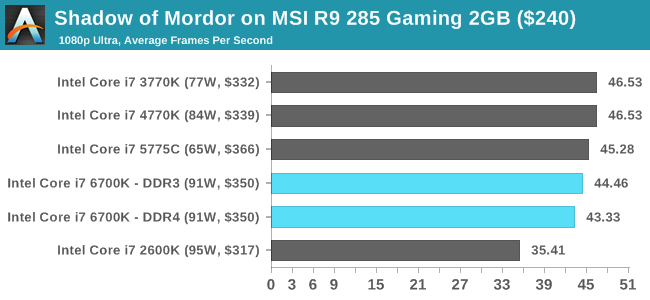
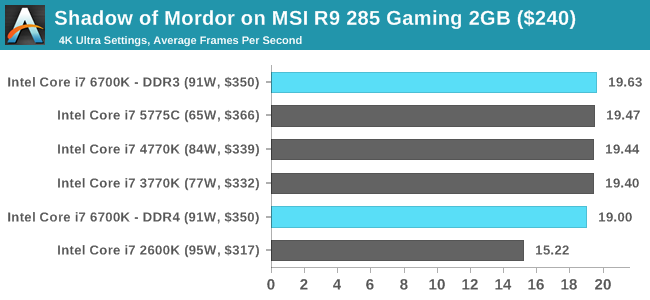

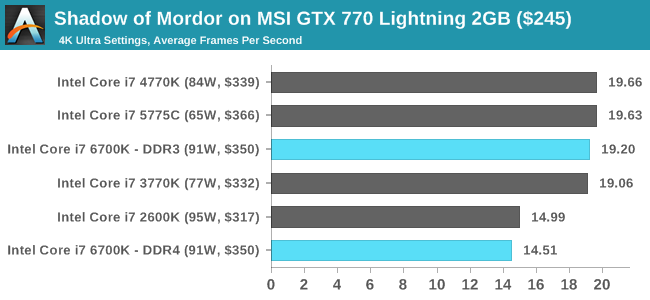















477 Comments
View All Comments
zShowtimez - Wednesday, August 5, 2015 - link
With 0 competition at the high end, its not really a surprise.Refuge - Wednesday, August 5, 2015 - link
^this^darkfalz - Wednesday, August 5, 2015 - link
Yeah, sad. Single digit generational IPC improvements and a trickle up of clockspeed - not exactly exciting times in the CPU world. But I'm kind of happy, in a way, as who wants to have to upgrade their whole system rather than just the GPU every 2 years. It strikes me that Intel are doing a pissload of work for very little results though.wallysb01 - Wednesday, August 5, 2015 - link
What’s lost is that these gains are coming with roughly zero increased power draw. Much of the gains of years past were largely due to being able to increase the power consumption without melting things. Today, we’ve picked all the low hanging fruit in that regard. There is just no point in being disappointed in 5-10% increases in performance, as time moves on its only going to get worse.There is also no point in getting mad at AMD for not providing competition to push intel or at Intel for not pushing themselves enough. If added performance was easy to come by we’d see Intel/AMD or some random start up do it. The market is huge and if Intel could suddenly double performance (or cut power draw in half with the same performance) they would do it. They want you to replace your old Intel machine with a new one just as much as they want to make sure your new computer is Intel rather than AMD.
boeush - Thursday, August 6, 2015 - link
And yet, one would expect much lower operating voltage and/or much higher base clocks with a new architecture on a 14nm process, as compared to the 22nm Haswell. The relatively tiny improvements in everything except iGPU speaks to either misplaced design priorities (i.e. incompetence) or ongoing problems with the 14nm process...Achaios - Wednesday, August 5, 2015 - link
Very often. You are simply NOT a gamer. There are games that depend almost completely on CPU single threaded performance: World of Warcraft, Total War series games, Starcraft II, etc.Nagorak - Wednesday, August 5, 2015 - link
The games you listed aren't ones where I'd think having hundreds of FPS would be necessary.jeffkibuule - Thursday, August 6, 2015 - link
FPS can vary wildly because so many units end up on screen.vdek - Thursday, August 6, 2015 - link
I'm a gamer, I plan a ton of SCII, my Xeon 5650 6 core @ 4.2 ghz does just fine on any of those mentioned games. Why should I upgrade?Kjella - Wednesday, August 5, 2015 - link
Yeah. I upgraded from the i7-860 to the i7-4790K, the only two benchmarks they have in common in Bench suggests that's roughly a 100% upgrade. And a lot of that is the huge boost to base clock on the 4790 vs the 4770, I prefer running things at stock speed since in my experience all computers are a bit unstable and I'd rather not wonder if it's my overclocking..
At this rate it looks like any Sandy Bridge or newer is basically "use it until it breaks", at 5-10% increase/generation there's no point in upgrading for raw performance. 16GB sticks only matter if you want more than 4x8GB RAM. PCIe 3.0 seems plenty fast enough. And while there's a few faster connectors, that's accessories. The biggest change is the SSD and there you can always add an Intel 750 PCIe card instead for state of the art 4x PCIe 3.0 NVME drive. Makes more sense than replacing the system.